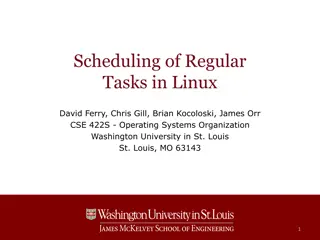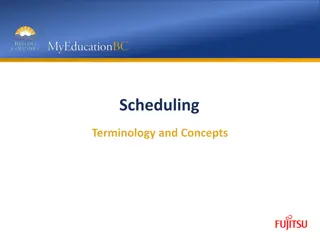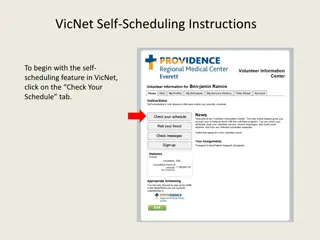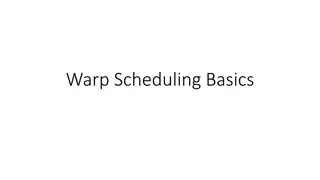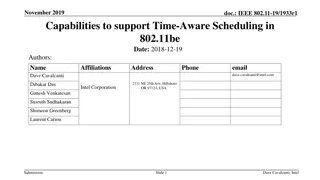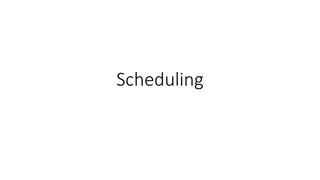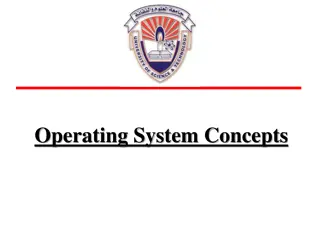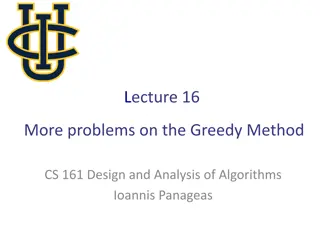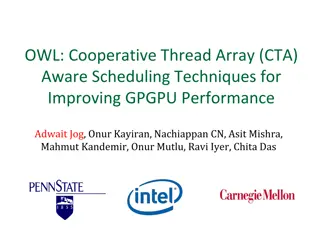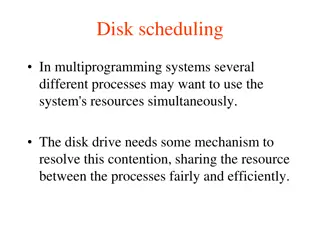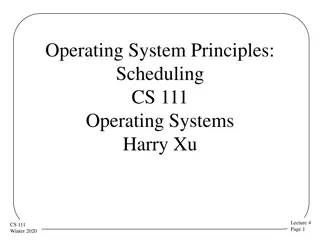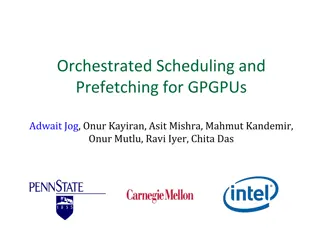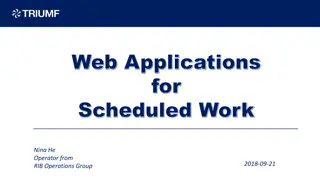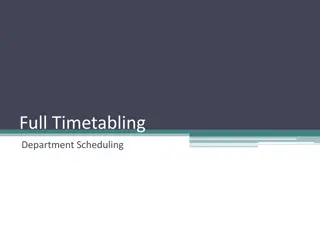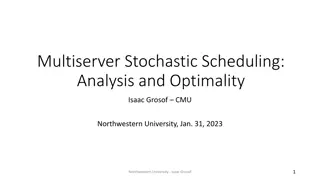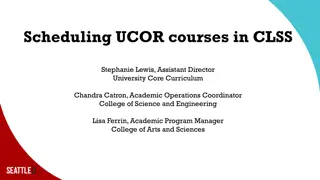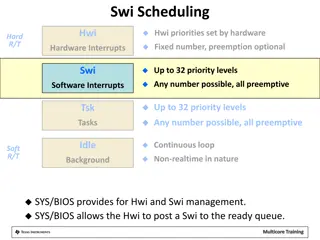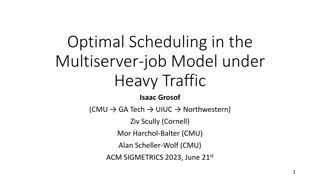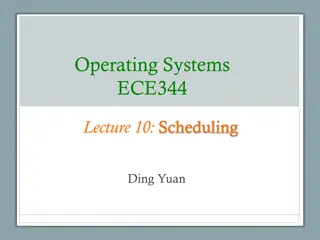
Understanding CPU Scheduling in Operating Systems
Explore the concepts of CPU scheduling in operating systems, including multiprocessing, real-world examples, possible metrics, and simplifying assumptions. Learn about scheduling algorithms like First In, First Out (FIFO) and Shortest Job First (SJF) with practical examples.
Download Presentation

Please find below an Image/Link to download the presentation.
The content on the website is provided AS IS for your information and personal use only. It may not be sold, licensed, or shared on other websites without obtaining consent from the author. If you encounter any issues during the download, it is possible that the publisher has removed the file from their server.
You are allowed to download the files provided on this website for personal or commercial use, subject to the condition that they are used lawfully. All files are the property of their respective owners.
The content on the website is provided AS IS for your information and personal use only. It may not be sold, licensed, or shared on other websites without obtaining consent from the author.
E N D
Presentation Transcript
CPU Scheduling CS 105
Review: Multiprocessing The Illusion The Reality Abstraction: logical control flow within a process Context switching b/n processes User cannot predict how instructions will interleave
Real-world Examples Restaurants handling orders DMV handling customers Students handling assignments Hospitals handling patients
Possible Metrics Latency: how much time between when a job is requested and when a job is completed Response time: how much time between when a job is requested and when you start processing the job Throughput: the rate at which jobs are completed
Simplifying Assumptions (for now) 1) Once you start a job, you complete that job before beginning the next job 2) The run-time of each job is known in advance 3) All jobs only use the CPU
First In, First Out (FIFO) Jobs are scheduled in the order they arrive Example: Job A arrives at time 0, takes time 10 to complete Job B arrives at time 5, takes time 10 to complete Job C arrives at time 10, takes time 10 to complete A B C Time 0 20 40 60 80 100 120 Average Latency = 10+15+20 Average Response = 0+5+10 Throughput = 3 = 15 = 5 3 3 30 = .1
Exercise 1: First In, First Out (FIFO) Jobs are scheduled in the order they arrive Example: Job A arrives at time 0, takes time 100 to complete Job B arrives at time 5, takes time 10 to complete Job C arrives at time 10, takes time 10 to complete A B C Time 0 20 40 60 80 100 120 Average Latency = 100+105+110 Average Response = 0+95+100 Throughput = = 105 = 65 3 3 120 = .025 3
Shortest Job First (SJF) Jobs are scheduled in order of length (shortest first) Example: Job A arrives at time 0, takes time 10 to complete Job B arrives at time 5, takes time 100 to complete Job C arrives at time 10, takes time 10 to complete A C B Time 0 20 40 60 80 100 120 Average Latency = 10+115+10 Average Response = 0+15+0 Throughput = = 45 = 5 3 3 120 = .025 3
Exercise 2: Shortest Job First (SJF) Jobs are scheduled in order of length (shortest first) Example: Job A arrives at time 0, takes time 100 to complete Job B arrives at time 5, takes time 10 to complete Job C arrives at time 10, takes time 10 to complete A B C Time 0 20 40 60 80 100 120 Average Latency = 100+105+110 Average Response = 0+95+100 Throughput = = 105 = 65 3 3 120 = .025 3
Simplifying Assumptions (for now) 1) Once you start a job, you complete that job before beginning the next job 2) The run-time of each job is known in advance 3) All jobs only use the CPU
Shortest Time-to-Completion First (STCF) The job with the shortest time-to-completion is scheduled next If a job arrives with a shorter time-to-completion then the current job, it preempts the current job Example: Job A arrives at time 0, takes time 100 to complete Job B arrives at time 5, takes time 10 to complete Job C arrives at time 10, takes time 10 to complete A B C A Time 0 20 40 60 80 100 120 Average Latency = 120+10+15 Average Response = 0+0+5 Throughput = = 48.3 3 3 = 1.6 120 = .025 3
Simplifying Assumptions (for now) 1) Once you start a job, you complete that job before beginning the next job 2) The run-time of each job is known in advance 3) All jobs only use the CPU
Round Robin (RR) Run jobs for a fixed time slice (e.g., 2), cycle through all job that are not yet completed Example: Job A arrives at time 0, takes time 10 to complete Job B arrives at time 0, takes time 10 to complete Job C arrives at time 0, takes time 10 to complete A B CA B CA BCA BC A BC Time 0 20 40 60 80 100 120 Average Latency = 26+28+30 Average Response = 0+2+4 Throughput = 3 = 28 3 3 = 2 30 = .1
Exercise 3: Round Robin (RR) Run jobs for a fixed time slice (e.g., 2), cycle through all job that are not yet completed Example: Job A arrives at time 0, takes time 100 to complete Job B arrives at time 10, takes time 10 to complete Job C arrives at time 10, takes time 10 to complete B CA BC A B C A A B CA B CA Time 0 20 40 60 80 100 120 Average Latency = 120+26+28 Average Response = 0+0+2 Throughput = = 58 3 3 = .6 120 = .025 3
Simplifying Assumptions (for now) 1) Once you start a job, you complete that job before beginning the next job 2) The run-time of each job is known in advance 3) All jobs only use the CPU
Processes are not all the same CPU-bound processes use a lot of CPU e.g., compiling, scientific computing applications, mp3 encoding A Time 0 20 40 60 80 100 120 I/O-bound processes use CPU in short bursts e.g., browsing small webpages, indexing a file system A A A A A A A Time 0 20 40 60 80 100 120 Balanced processes are somewhere in between e.g., playing videos, moving windows around
Comparing Scheduling Algorithms FIFO works well if jobs are short otherwise bad latency and bad response time STCF good latency very uneven response time (bad fairness) assumes run-time of each job is known in advance RR good response time bad latency + overhead of context switching poor fairness for mixes of CPU-bound and I/O-bound
Multi-level Feedback Queues Goal: optimize latency while minimizing response time for interactive jobs without knowing run-time of jobs in advance General idea: maintain multiple queues, each with a different priority level Scheduling rules: 1) If Priority(A) > Priority(B), run A 2) If Priority(A) = Priority(C), run A and C Round Robin 3) When a job enters the system, it is place in the highest priority queue 4) Once a job uses up its time allotment at current priority level, it moves down one queue 5) After some time period, move all jobs in the system to the highest priority queue Q5 A C D Higher Priority Q4 Q3 B Q2 Q1
Schedulers in Operating Systems CPU Scheduler selects next process to run from the runnable pool Page Replacement Scheduler selects page to evict Disk Scheduler selects next read/write operation to perform Network Scheduler selects next packet to send/process
Exercise 4: Feedback 1. Rate how well you think this recorded lecture worked 1. Better than an in-person class 2. About as well as an in-person class 3. Less well than an in-person class, but you still learned something 4. Total waste of time, you didn't learn anything 2. How much time did you spend on this video (including exercises)? 3. Do you have any particular questions you d like me to address in this week s problem session? 4. Do you have any other comments or feedback?


